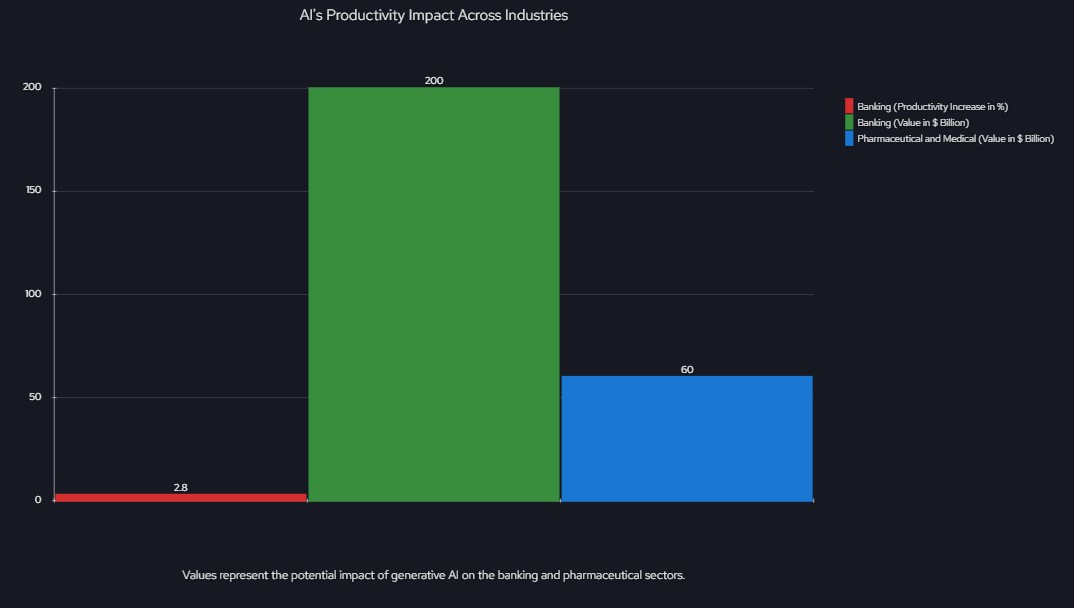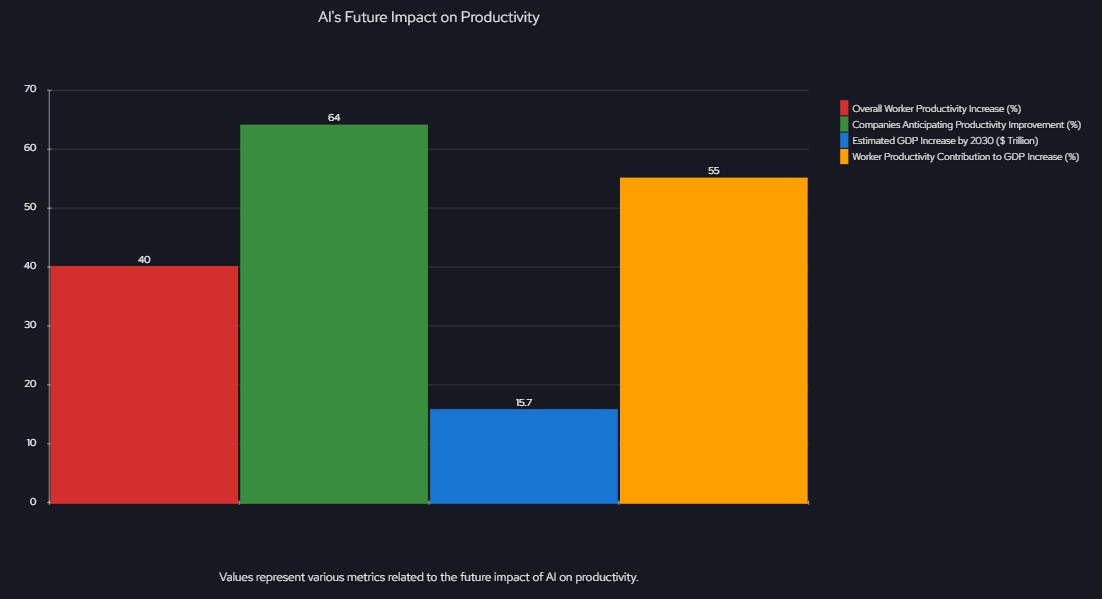Top AI Productivity Statistics 2023 (Workplace & Business)
AI has become a big deal for boosting productivity across industries. As technology continues to evolve, it’s clear that integrating AI is the way to reach new levels of productivity and creativity.
But how exactly does artificial intelligence connect to productivity? What real impact can AI have to crank things up a notch? What’s the deal with its role in getting more done?
In this article, we’ll dive into some fascinating stats that show how AI is seriously amping up productivity. We’ll check out key data points to help you better understand where AI productivity is at now and where it’s headed in the future.
- , AI

Top AI Productivity Statistics
The adoption of AI increases business productivity by 40%.
The adoption of generative AI is predicted to result in a productivity increase of 1.5% annually, almost tripling the pace seen between 2010 and 2018.
By 2040, the incorporation of generative AI and other automation techniques might increase productivity by a possible 3.3% annually, opening up a new area for productivity improvement.
Employee productivity has reportedly been boosted by 61% as a result of greater AI usage at work.
With AI applications in enterprises, labor productivity is predicted to rise by around 30%.
AI will increase corporate efficiency, according to 64% of respondents, and 42% think it will simplify work procedures.
Over a ten-year period, productivity improvements brought on by AI may increase the global GDP by 7%.
As a result of artificial intelligence, a recent report predicts that labor productivity in developed nations could increase by up to 40% by 2035.
In Sweden, a 37% boost in AI output is anticipated. Japan (34%) and the U.S. (35%) are also anticipated to gain a lot from AI’s impacts.
79% of managers believe AI will make their jobs easier and more effective, while 54% of managers claim that using AI at work has enhanced productivity.
Generative AI can contribute between $2.6 and $4.4 trillion to annual global GDP across 63 different use cases.
Adoption of AI could boost GDP by up to $13 trillion by 2030.
AI will result in a 40% increase in overall worker productivity.
64% of companies are anticipating an improvement in productivity as a result of AI.
Market Size of AI in Productivity
Generative AI can contribute between $2.6 and $4.4 trillion to annual global GDP across 63 different use cases (McKinsey Insights)
A recent study conducted by McKinsey Insights suggests that generative artificial intelligence might contribute between $2.6 and $4.4 trillion to annual global GDP across 63 different use cases.
This results in an increase of between 15% and 40% in the overall effect of AI. The productivity boost that generative AI can bring to the world economy could amount to billions of dollars.
If generative AI is implemented into more software applications, the effect may be increased by a factor of two.
Adoption of AI could boost GDP by up to $13 trillion by 2030, or 1.2% more GDP growth annually (McKinsey Insights)
According to a calculation utilizing McKinsey survey data, the adoption of AI may increase the global GDP by as much as $13 trillion by 2030, or approximately 1.2% more GDP growth per year.
However, this impact won’t materialize right away since the majority of the expenditures associated with using AI can exceed the potential for financial gain.
AI-Driven Productivity Surge
AI productivity gains are projected to reach 37% in Sweden by 2035, followed closely by Finland at 36% and the USA at 35% (DevriX)
The realm of AI is set to revolutionize productivity, with Sweden expected to lead the charge with a remarkable 37% growth by 2035.
In close pursuit, Finland and the USA anticipate gains of 36% and 35%, respectively, while Japan and Austria also project substantial improvements of 34% and 30%.
Countries | % Age of Productivity |
Sweden | 37% |
Finland | 36% |
USA | 35% |
Japan | 34% |
Austria | 30% |
Germany | 29% |
Netherlands | 27% |
UK | 25% |
France | 20% |
Belgium | 17% |
Italy | 12% |
Spain | 11% |
The Impact of AI on Productivity
According to an impressive 61% of employees, AI has increased productivity at work (SnapLogic, 2021)
An impressive 61 percent of employees attribute increased workplace productivity to AI. Additionally, AI fosters team cooperation, as more than a third of workers observe enhanced collaboration among teams.
This favorable attitude towards AI is mirrored by over two-thirds of employees expressing a keen interest in greater AI integration within their professional surroundings.
See also our article on AI in workplace statistics.
49% of participants acknowledged better decision-making and faster insights, while 51% said AI supported attaining a better work-life balance. 61% of participants recognized AI’s contribution to an effective and productive workday (VentureBeat)
When asked about the benefits of AI integration in a recent poll, a significant 61% of respondents said that it made workdays more productive and streamlined.
Nearly 50% of respondents (49%) also said that AI has a beneficial influence on their decision-making processes, resulting in faster insights.
Additionally, slightly more than half (51%) of the participants expressed the opinion that AI is crucial to creating a better work-life balance.
AI’s Productivity Impact Across Industries
By increasing productivity by 2.8% to 4.7%, or an extra $200 billion to $340 billion, generative AI could have a substantial positive influence on the banking sector (McKinsey Insights)
The prior use of artificial intelligence in areas like marketing and customer operations has already greatly helped the banking industry.
Uses of generative artificial intelligence might provide further advantages, particularly due to the prevalence of text modalities in areas including laws and programming languages, as well as the fact that the sector is customer-facing and serves a large number of B2C and small-business clients.
Between 2.6% and 4.5% of yearly sales, or $60 billion to $110 billion annually, might be affected by generative AI in the pharmaceutical and medical product sectors (McKinsey Insights)
The fact that the process of discovering new therapeutic compounds requires a large number of resources gives rise to this substantial possibility.
The average time it takes to develop a new medicine is ten to fifteen years, and pharmaceutical firms typically devote around 20% of their profits to Research and Development.
Considering these huge expenditures and lead times, improving Research and Development’s effectiveness and quality may result in significant value.
Adoption of generative AI might result in productivity gains of between 0.2% and 3.3% annually, which would balance out a decline in job growth and promote economic growth as a whole (McKinsey Insights)
Technology, including generative AI, can boost productivity, reversing the loss of jobs and promoting economic development.
According to our estimates, work automation could improve global productivity by 0.23 to 3.3% per year (2023–2040).
Boosting Productivity Using Generative AI
With an expected 0.1% to 0.6% yearly increase until 2040, generative AI has great potential for increasing worker productivity (McKinsey Insights)
Depending on the rate of technological adoption and the reallocation of worker time, generative AI has the potential to promote a labor productivity increase of 0.1% to 0.6% annually until 2040.
Combining generative AI with other technologies may boost productivity by an additional 0.2% to 3.3% annually. However, a crucial role will be played by effective worker assistance for skill development and career changes.
Ultimately, generative AI has the potential to dramatically boost economic development and promote a more diverse and sustainable world if properly handled.
AI-driven conversational assistant implementation led to a 14% increase in issue resolution per hour, using data from 5,179 customer support agents (National Bureau of Economic Research)
Recent research conducted by the National Bureau of Economic Research looked at the consequences of introducing a conversational assistant powered by AI to a group of 5,179 customer service representatives.
The findings demonstrated a substantial increase of 14% in the number of problems answered each hour.
Sweden, the U.S., and Japan could see productivity rise by around 37%, 35%, and 34% respectively, while Germany and Austria might experience up to 30% labor productivity improvement through AI in the next 15 years (Statista)
According to the report, the impact of artificial intelligence could increase labour productivity in advanced countries by as much as 40% by 2035.
Notable boosts are expected in Japan (34%), Sweden (37%), the U.S. (35%), Germany, and Austria within the next 15 years.
AI’s Transformative Impact and Benefits on Productivity
Technology-driven applications might replace up to 300 million full-time employees while simultaneously creating a number of unique job categories that could result in a 7% annual rise in global productivity over the course of a decade (Harvard Business Review)
Recent Goldman Sachs research predicted a major possible change in the employment environment.
According to their estimate, technological improvements might lead to the replacement of up to 300 million full-time jobs with apps that are driven by technology.
However, it is envisaged that this shift would have a balanced impact by leading to the birth of various new employment categories.
With a projected increase of around 7% each year over the course of ten years due to these developments, the productivity landscape might significantly improve.
How does AI-driven Productivity Affect the Economy, Job Market, and GDP?
In 63 use case scenarios, generative AI could add $2.6 trillion to $4.4 trillion yearly, or 15% to 40%, to the projected economic value of nongenerative AI and analytics, which is between $11 trillion and $17.7 trillion (McKinsey Insights)
With 63 use cases across 16 business processes, generative AI has a wide range of possible applications and has the potential to provide significant financial gains. When implemented across diverse businesses, these advantages are predicted to vary from $2.6 trillion to $4.4 trillion annually.
Importantly, this anticipated effect would add 15% to 40% to the current economic value of nongenerative artificial intelligence and analytics, which ranges from $11 trillion to $17.7 trillion. The synergistic impact of generative AI opens up a potentially significant path for economic development and sectoral improvement.
Four essential business functions—software engineering, customer operations, marketing and sales, and research and development—combine to account for around 75% of the yearly value from generative AI use cases (McKinsey Insights)
Examining 16 different company areas, it becomes clear that only four exhibit a significant concentration of value. These activities have the potential to account for around 75% of the yearly value generated by the use of generative AI.
This targeted distribution emphasizes the importance of these particular fields in using the significant advantages provided by generative AI, highlighting their key function in promoting productivity, creativity, and operational efficiency.
AI Tools and Platforms Enhancing Productivity
Customer service representatives’ productivity increased by over 14% while utilizing generative pre-trained transformer (GPT) AI technology (National Bureau of Economic Research)
According to a National Bureau of Economic Research (NBER) report, customer care representatives who used a generative pre-trained transformer (GPT) AI tool showed an improvement in productivity of over 14%.
Since non-sales sources of information are preferred by 59% of consumers, AtOnce and other AI solutions are being strategically used to increase productivity and save expenses (AtOnce)
An important change was discovered by a recent Forrester survey, which found that 59% of consumers preferred information from sources other than direct sales encounters. Utilizing AI-powered solutions like AtOnce is a smart investment that may increase production while reducing costs.
Traditional sales training has a minimal 16% rate of retention following 90 days, but AI-powered business tools provide real-time mentoring and feedback to salespeople, resulting in an increase in productivity (AtOnce)
Recent data that highlighted a retention rate of just 16% for sales training after 90 days highlights the need for an alternate approach to training.
Tools that are driven by AI provide a solution to the problem by delivering real-time coaching and feedback to sales personnel. This results in improved overall performance as well as increased overall productivity.
Challenges and Limitations in AI-Driven Productivity
Automation and AI will increase productivity and economic development, but by 2030, millions of workers may need to change their employment or acquire new skills ((McKinsey Insights)
The forecasts of occupational shifts to 2030 point out a “step-up” scenario where proactive actions by governments and businesses foster job creation over the next 15 years. However, they are illustrations rather than predictions and depend on scenarios of automation-displaced work and emerging trends such as rising incomes and increased healthcare spending.
Occupations | China | Germany | India | Japan | Mexico | US |
Creators | 85% | 17% | 58% | -4% | 28% | 8% |
Technology Professionals | 50% | 59% | 129% | 15% | 27% | 34% |
Teachers | 119% | 17% | 208% | -8% | 37% | 9% |
Managers and Executives | 40% | 21% | 75% | 0% | 24% | 15% |
Builders | 9% | 13% | 117% | -16% | 48% | 35% |
Care Providers | 122% | 25% | 242% | -1% | 83% | 30% |
Professionals | 26% | 20% | 46% | 2% | 32% | 11% |
Office Support | 14% | -15% | 21% | -23% | 22% | -20% |
Predictable Physical Work | -4% | 21% | 15% | -33% | 8% | -31% |
Customer Interaction | 36% | 11% | 46% | -13% | 15% | -1% |
Unpredictable Physical Work | 12% | -6% | 9% | -5% | 16% | 6% |
AI’s Future Impact on Productivity
AI will result in a 40% increase in overall worker productivity (PWC)
PWC’s insights reveal a significant forecast: the adoption of AI is poised to usher in a remarkable 40% surge in the overall productivity of workers.
This anticipated increase underscores the transformative potential of AI in reshaping the efficiency and effectiveness of various industries.
64% of companies are anticipating an improvement in productivity as a result of AI (Forbes)
A significant 64% of organizations are anxiously expecting an increase in productivity as a result of the integration of AI, according to a noteworthy figure that has emerged. This reflects the rising optimism about AI’s ability to revolutionize how businesses operate.
By 2030, the estimated impact of AI on production might increase the global GDP by $15.7 trillion, with increased worker productivity expected to account for more than 55% of these gains (BSC Group)
Artificial intelligence (AI) is expected to boost production over the next ten years, which might result in a startling $15.7 trillion rise in the global GDP by 2030. Further highlighting the significance, recent research points out that impressive increases in worker productivity are anticipated to account for more than 55% of these GDP benefits from AI.
Conclusion
The numbers clearly show how AI is transforming work across industries. Adopting AI is leading to major productivity gains, especially with generative AI anticipated to rapidly accelerate progress.
Industries like banking, healthcare, and customer service stand to benefit a lot from integrating AI. While automation may negatively affect the labor market and jobs, it also has the potential to expand employment opportunities and increase worker satisfaction.
Looking ahead, it’s clear AI will have a huge impact on economic growth and workforce productivity. Businesses and the concept of work will change dramatically thanks to how AI enhances efficiency.
In summary, the data highlights that AI is a transformative technology that will reshape industries and redefine productivity. Businesses that embrace AI will be best positioned to unlock its benefits and see substantial efficiency gains.
The future looks bright as AI augments how we work! These statistics give us a glimpse into the productivity potential that lies ahead.
References
Employees want more AI in the workplace. (2022, October 14). SnapLogic. https://www.snaplogic.com/resources/infographics/employees-want-more-ai-in-the-workplace
Rao, A., & Greenstein, B. (2022). PwC 2022 AI business survey. PwC. https://www.pwc.com/us/en/tech-effect/ai-analytics/ai-business-survey.html
Haan, K. (2023, April 24). How businesses are using artificial intelligence in 2023. Forbes Advisor. https://www.forbes.com/advisor/business/software/ai-in-business
The economic potential of generative AI: The next productivity frontier. (2023, June 14). McKinsey & Company. https://www.mckinsey.com/capabilities/mckinsey-digital/our-insights/the-economic-potential-of-generative-ai-the-next-productivity-frontier#business-and-society
Chakravorti, B. (2023, June 25). How will AI change work? A look back at the ‘productivity paradox’ of the computer age shows it won’t be so simple. Fortune. https://fortune.com/2023/06/25/ai-effect-jobs-remote-work-productivity-paradox-computers-iphone-chatgpt/
Manyika, J., & Bughin, J. (2018, October 15). The promise and challenge of the age of artificial intelligence. McKinsey & Company. https://www.mckinsey.com/featured-insights/artificial-intelligence/the-promise-and-challenge-of-the-age-of-artificial-intelligence
Marr, B. (2023, June 27). Boost your productivity with generative AI. Harvard Business Review. https://hbr.org/2023/06/boost-your-productivity-with-generative-ai
Measuring the productivity impact of generative AI. (2023, June 6). NBER. https://www.nber.org/digest/20236/measuring-productivity-impact-generative-ai
Akhtar, A. (2023). Boost Sales Productivity with AI Investment | 2023 Guide. AtOnce. https://atonce.com/blog/sales-productivity-investment#how-ai-can-boost-your-sales-productivity
AI offers major productivity boost for global economy. (2019, October 17). BSC group. https://bscgroup.ee/ai-offers-major-productivity-boost-global-economy/
How artificial intelligence affects digital marketing. (2021, March 30). DevriX. https://devrix.com/tutorial/how-artificial-intelligence-affects-digital-marketing/
McKendrick, J. (2023, April 25). Yes, AI Increases Productivity, Study Suggests. Forbes. https://www.forbes.com/sites/joemckendrick/2023/04/25/yes-ai-increases-productivity-study-suggests/?sh=2227c05e12c2
Raymond, L., Brynjolfsson, B., & Li, D. (2023, April). Generative AI at work. NBER. https://www.nber.org/papers/w31161
Wiggers, K. (2021, July 20). The landscape of qualitative research — which approach is best? VentureBeat. https://venturebeat.com/business/the-landscape-of-qualitative-research-which-approach-is-best/
Buchholz, K. (2020, December 15). Infographic: Where AI is aiding productivity. Statista Daily Data. https://www.statista.com/chart/23779/ai-productivity-increase/
Patryk Miszczak







